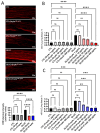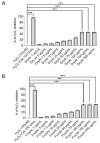Vasculo-Protective Effects of Standardized Black Chokeberry Extracts in Mice Aorta
- PMID: 39769283
- PMCID: PMC11677783
- DOI: 10.3390/ijms252413520
Vasculo-Protective Effects of Standardized Black Chokeberry Extracts in Mice Aorta
Abstract
Black chokeberry (Aronia melanocarpa <Michx.> Elliot) represents a rich source of dietary polyphenols and other bioactive phytochemicals with pleiotropic beneficial cardiovascular effects. The present study was aimed at evaluating the ex vivo effects of two black chokeberry extracts (BChEs), obtained from either dry (DryAr) or frozen (FrozAr) berries, on oxidative stress and vascular function in mice aortic rings after incubation with angiotensin 2 (Ang 2), lipopolysaccharide (LPS) and glucose (GLUC) in order to mimic renin-angiotensin system activation, inflammation and hyperglycemia. The identification of phenolic compounds was performed by means of liquid chromatography with a diode array detector coupled with mass spectrometry using the electrospray ionization interface. The BChE obtained from the FrozAr was rich in cyanidin glucoside, rutin and caffeic acid, while the one obtained from the dried berries was rich in rutin, caffeic acid and chlorogenic acid. Mice aortas were dissected and acutely incubated (12 h) with Ang2 (100 nM), LPS (1 µg/mL) or GLUC (400 mg/dL) in the presence vs. absence of the two BChEs (1, 10, 50, 75, 100, 500 µg/mL). Subsequently, the tissues were used for the assessment of (i) hydrogen peroxide (H2O2) and superoxide production (using two methods, spectrophotometry and immunofluorescence), (ii) H2O2 scavenger effect and (iii) vascular reactivity (using the organ bath/myograph system). After exposure to Ang2, LPS or GLUC, both types of extracts decreased the H2O2 and superoxide levels in a concentration-dependent manner starting from either 50 µg/mL or 100 µg/mL. Also, in the highest concentrations (100 µg/mL, 150 µg/mL and 500 µg/mL), both extracts elicited a significant scavenger effect on H2O2 (similar to catalase, the classic H2O2 scavenger). Moreover, at 100 µg/mL, both extracts were able to significantly improve vascular relaxation in all stimulated aortic rings. In conclusion, in mice aortas, black chokeberry extracts in acute application elicited a concentration-dependent vasculo-protective effect through the reduction of oxidative stress and the alleviation of endothelial dysfunction in ex vivo conditions that mimic cardio-metabolic diseases.
Keywords: HLPC characterization; black chokeberry; dried and frozen extracts; endothelial dysfunction; hydrogen peroxide; oxidative stress; superoxide anion.
Conflict of interest statement
The authors declare no conflicts of interest.
Figures





References
MeSH terms
Substances
Grants and funding
LinkOut - more resources
Full Text Sources
Miscellaneous

